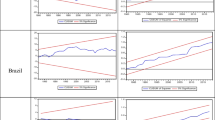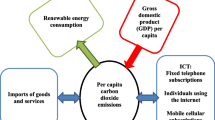Abstract
This paper analyzes the relation between income and emissions in the period 1970–2008, for all world countries. We consider time-series of CO2, SO2 and GWP100, and use Vector Autoregressive models that allow for nonstationarity and cointegration. At 5 % significance level, income and emissions are found to be driven by unrelated random walks with drift (respectively by a common random walk with drift) in about 70 % (respectively 25 %) of cases; in the remaining cases the variables are trend-stationary. Tests of Granger-causality show evidence of both directions of causality. For the case of unrelated stochastic trends, we almost never find income driving emissions, as predicted by a consumption-function interpretation. These causality results and the absence of a common trend challenge the main implications of the Environmental Kuznets Curve, namely that the dominant direction of causality should be from income to emissions, and that for increasing levels of income, emissions should tend to decrease.




Similar content being viewed by others
Notes
Many non monotonic forms of this relation have been considered in the EKC literature; the inverted U shape is a representative of this class.
I(1) processes are often called ‘stochastic trends’; one such process is the random walk.
Verbeke and De Clercq (2006) remarked that, “most empirical papers do not report whether the series are integrated or not. Basically this means that there is no way to tell if the reported results are due to the EKC or are spurious.”
Several investigators, see Stern (2004, 2010), have favored a monotonic emissions-income relation instead of a non-monotonic one. Several studies, see the list of references on page 2181 in Stern (2010), do not find support for a non-monotonic emissions-income relation as predicted by the EKC hypothesis.
The points in the right graph in Fig. 1 were obtained by selecting \(y\) values in the interval \([0,5]\) using a uniform distribution, and adding \(N(0,1)\) noise to the corresponding slopes.
In fact when \(k=1\), the test of \(r=0\) is really a test that \(\Delta x_t \) is a white-noise process with no short-run dynamics.
See the following Sect. 5.3 for a definition of the ECM.
Given that the GDP series for the US is common to the system with GWP and SO2, the selected ranks of 1 and 2 are not consistent, because GDP either contains an I(1) component or not. This is a limitation of the inferential procedure. In the following we do not try to resolve these conflicts, but proceed in the analysis taking the selected cointegration rank as given.
As noted in Lütkepohl (2005) and in Baek et al. (2009), \(\beta _{2}\) is not an elasticity due to the presence of dynamics in the system, see Johansen (2005) for an interpretation of identified cointegrating coefficients in terms of a counterfactual experiment involving the long-run of the system. Here we simply interpret \(\beta _{2}\) as the slope of the emissions-income relation.
If the corresponding hypotheses implied both \(\beta _{1}=\beta _{2}=0\), we relaxed the restriction on the coefficient of \(x_{1t}\) or \(x_{2t}\) with highest \(p\)-value in the single-coefficient significance tests.
\(P(t<t_{\zeta _i})\) in Table 8 indicates the \(p\)-value for a one-sided test against the alternative \(\zeta _i < 0\), while \(P(|t|>t_{\zeta _i})\) is the \(p\)-value against a two-sided alternative.
References
Ang JB (2007) CO2 emissions, energy consumption, and output in France. Energy Policy 35(10):4772–4778
Baek J, Cho Y, Koo WW (2009) The environmental consequences of globalization: a country-specific time-series analysis. Ecol Econ 68(8–9):2255–2264
Balsamà AP, De Biase L, Janssens-Maenhout G, Pagliari V (2014) Near-term projection of anthropogenic emission trends using neural networks. Atmos Environ 89:581–592
Coondoo D, Dinda S (2002) Causality between income and emission: a country group-specific econometric analysis. Ecol Econ 40(3):351–367
Coondoo D, Dinda S (2008) Carbon dioxide emission and income: a temporal analysis of cross-country distributional patterns. Ecol Econ 65(2):375–385
Davidson JEH, Hendry DF, Srba F, Yeo S (1978) Econometric modelling of the aggregate time-series relationship between consumers’ expenditure and income in the united kingdom. Econ J 88:661–692
Dufour J, Pelletier D, Renault E (2006) Short run and long run causality in time series: inference. J Econ 132:337–362
EC-JRC/PBL (2011) Emission Database for Global Atmospheric Research (EDGAR), release version 4.1. Database and Technical report. European Commission, Joint Research Centre (JRC) & Netherlands Environmental Assessment Agency (PBL), http://edgar.jrc.ec.europa.eu/overview.php?v=41
Engle R, Granger C (1987) Co-integration and error correction: representation, estimation, and testing. Econometrica 55:251–276
Fanelli L, Paruolo P (2010) Speed of adjustment in cointegrated systems. J Econ 158:130–141
Gocheva-Ilieva S, Ivanov A, Voynikova D, Boyadzhiev D (2014) Time series analysis and forecasting for air pollution in small urban area: an sarima and factor analysis approach. Stoch Environ Res Risk Assess 28(4):1045–1060
Gonzalo J (1994) Five alternative methods of estimating long-run equilibrium relationships. J Econ 60:203–233
Granger CWJ, Newbold P (1974) Spurious regressions in econometrics. J Econ 2(2):111–120
Heston A, Summers R, Aten B (2011) Penn world table version 7.0. Tech. rep., Center for International Comparisons of Production, Income and Prices at the University of Pennsylvania
IPCC (2006) 2006 IPCC Guidelines for National Greenhouse Gas Inventories, vol 1. General Guidance and Reporting, Intergovernmental Panel on Climate Change
IPCC (2007) Contribution of working group III to the fourth assessment report of the intergovernmental panel on climate change, 2007. Cambridge University Press, Cambridge
Johansen S (1996) Likelihood-based inference in cointegrated vector auto-regressive models. Oxford University Press, Oxford
Johansen S (2005) Interpretation of cointegrating coefficients in the cointegrated vector autoregressive model. Oxf Bull Econ Stat 67:93–104
Keller C (2009) Global warming: a review of this mostly settled issue. Stoch Environ Res Risk Assess 23(5):643–676
Kim S, Kumar A (2005) Accounting seasonal nonstationarity in time series models for short-term ozone level forecast. Stoch Environ Res Risk Assess 19(4):241–248
Lütkepohl H (2005) New introduction to multiple time series analysis. Springer, Berlin
Lütkepohl H, Kratzig M (2004) Applied time series econometrics. Cambridge University Press, Cambridge
Meehl G, Stocker T, Collins W, Friedlingstein P, Gaye A, Gregory J, Kitoh A, Knutti R, Murphy J, Noda A, Raper S, Watterson I, AJ W, Zhao ZC (2007) Global climate projections. In: Solomon S, Qin D, Manning M, Chen Z, Marquis M, Averyt K, M T, Miller H (eds) Climate Change 2007: The physical science basis. Contribution of working group I to the fourth assessment report (AR4) of the intergovernmental panel on climate change (IPCC), chap 10.1. Cambridge University Press, Cambridge
Müller-Fürstenberger G, Wagner M (2007) Exploring the environmental Kuznets hypothesis: theoretical and econometric problems. Ecol Econ 62(3–4):648–660
Nakićenović N, Swart R (2000) Special report on emissions scenarios. A special report of working group III of the intergovernmental panel on climate change. Cambridge University Press, Cambridge
Nelson C, Plosser C (1982) Trends and random walks in macroeconomic time series: some evidence and implications. J Monet Econ 10:139–162
Omtzigt P, Paruolo P (2005) Impact factors. J Econ 128:31–68
Perman R, Stern DI (2003) Evidence from panel unit root and cointegration tests that the environmental Kuznets curve does not exist. Aust J Agric Resour Econ 47(3):325–347
Phillips P (1986) Understanding spurious regressions in econometrics. J Econ 33(3):311–340
Siebert H (2008) Economics of the environment - theory and policy, Seventh edn. Springer, Berlin
Stern DI (2004) The rise and fall of the environmental Kuznets curve. World Dev 32(8):1419–1439
Stern DI (2006) An atmosphere-ocean time series model of global climate change. Comput Stat Data Anal 51(2):1330–1346
Stern DI (2010) Between estimates of the emissions-income elasticity. Ecol Econ 69(11):2173–2182
Stern DI, Kaufmann RK (1999) Econometric analysis of global climate change. Environ Model Softw 14(6):597–605
Tamazian A, Rao BB (2010) Do economic, financial and institutional developments matter for environmental degradation? Evidence from transitional economies. Energy Econ 32(1):137–145
Verbeke T, De Clercq M (2006) The EKC: some really disturbing Monte Carlo evidence. Environ Model Softw 21:1447–1454
Wagner M (2008) The carbon kuznets curve: a cloudy picture emitted by bad econometrics? Resour Energy Econ 30(3):388–408
Acknowledgments
B. Murphy: Financial support from the EC-JRC is gratefully acknowledged.
Author information
Authors and Affiliations
Corresponding author
Electronic supplementary material
Below is the link to the electronic supplementary material.
Rights and permissions
About this article
Cite this article
Paruolo, P., Murphy, B. & Janssens-Maenhout, G. Do emissions and income have a common trend? A country-specific, time-series, global analysis, 1970–2008. Stoch Environ Res Risk Assess 29, 93–107 (2015). https://doi.org/10.1007/s00477-014-0929-9
Published:
Issue Date:
DOI: https://doi.org/10.1007/s00477-014-0929-9




